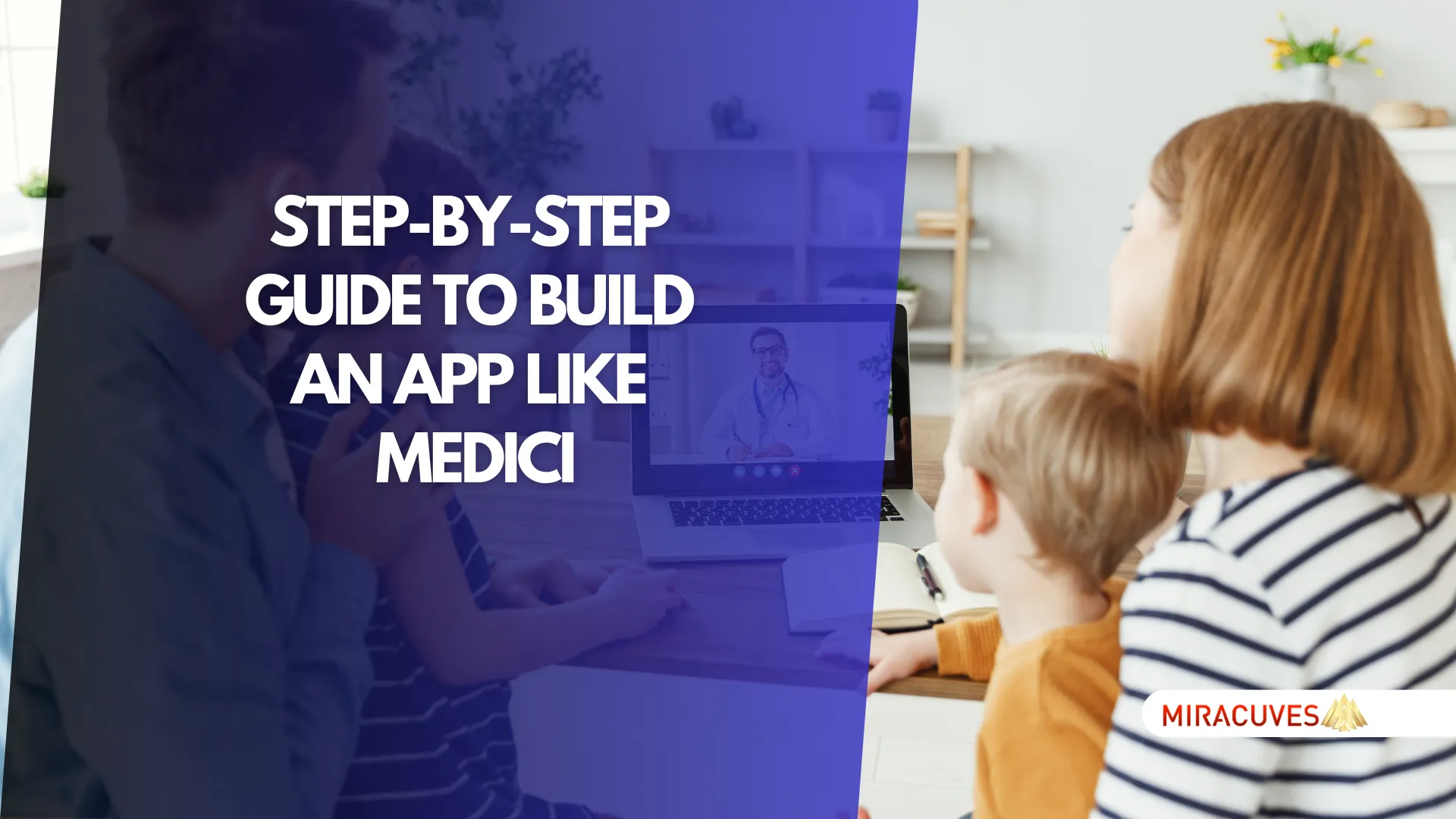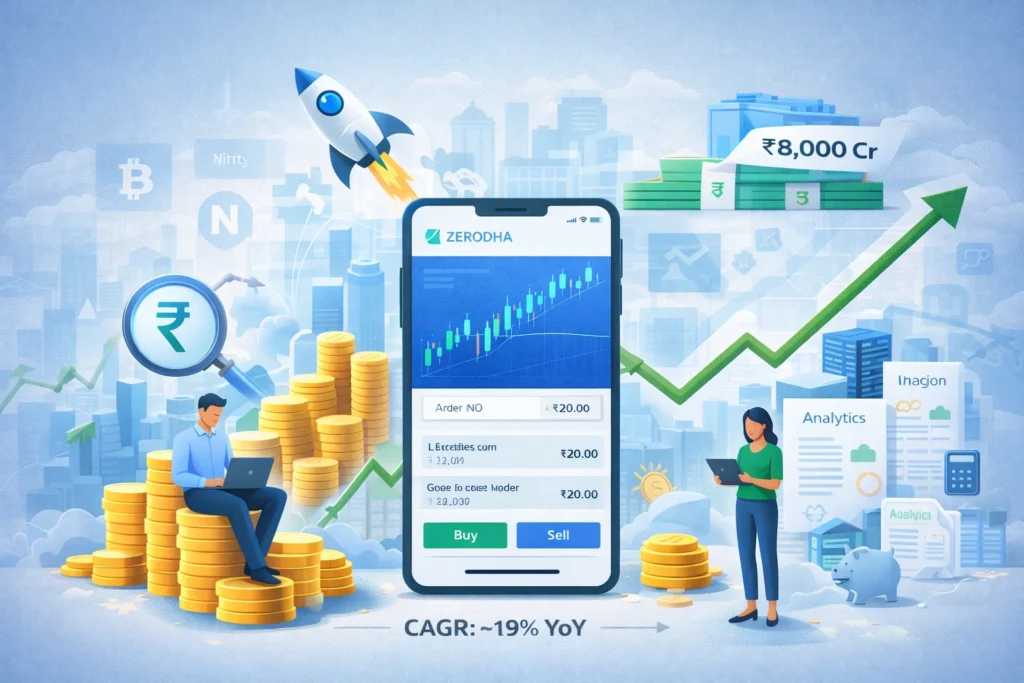In today’s fast-paced world, the healthcare industry is rapidly embracing digital solutions, and telehealth apps like Medici are at the forefront of this transformation. By connecting patients with healthcare providers through secure messaging, video consultations, and remote monitoring, Medici is reshaping how medical services are delivered. With the growing demand for accessible and efficient healthcare, building an app like Medici offers immense opportunities for developers, startups, and healthcare providers looking to enter this booming market.
This guide will walk you through the process of creating a Medici-like telehealth app, with insights on features, cost, and development timelines. Leveraging ready-made solutions, like those from Miracuves Solutions, you can build an app at a fraction of the global cost and significantly reduce the time to market.
What is Medici and What Does It Do?
Medici is a telehealth platform designed to simplify and enhance the way healthcare providers interact with their patients. By offering a range of virtual services, Medici allows doctors, therapists, and specialists to consult with patients remotely, using secure messaging and video calls. This not only improves access to healthcare but also reduces the need for in-person visits, making it an essential tool for modern-day healthcare delivery.
Key features of Medici include the ability to schedule appointments, conduct remote consultations, and manage prescriptions, all within a secure and user-friendly environment. Patients can access care from the comfort of their homes, while healthcare providers can streamline their workflows, making the delivery of care more efficient. Additionally, Medici integrates with various electronic health record (EHR) systems, allowing seamless updates to patient files and providing a comprehensive digital health experience.
With the rise in telemedicine, particularly in the post-pandemic era, apps like Medici are playing a crucial role in making healthcare more accessible to a broader population. Whether it’s routine check-ups or urgent consultations, Medici has become a model for how technology can revolutionize healthcare services.
| Feature | Medici | Teladoc | Amwell | Doctor on Demand |
|---|---|---|---|---|
| Secure Messaging | Yes | Yes | Yes | Yes |
| Video Consultations | Yes | Yes | Yes | Yes |
| Appointment Scheduling | Yes | Yes | Yes | Yes |
| Prescription Management | Yes | Yes | No | Yes |
| EHR Integration | Yes | Limited | Yes | No |
| Customizable Patient Profiles | Yes | No | Yes | Yes |
| Multi-Language Support | Yes | No | Yes | Yes |
Why Build an App Like Medici?
Telehealth is no longer just a trend; it’s becoming a cornerstone of modern healthcare. Building an app like Medici offers you the opportunity to tap into a rapidly growing industry that’s expected to reach a global market value of over $559 billion by 2027. As healthcare providers seek more efficient ways to connect with patients, telemedicine apps are providing the solution. Whether you are a startup or a well-established healthcare provider, developing an app like Medici can streamline patient care, enhance user satisfaction, and significantly boost your business.
By offering secure, remote access to healthcare, you can reduce barriers for patients in underserved areas and improve access to vital services. For providers, it means increasing their reach, cutting down operational costs, and optimizing appointment scheduling, prescription management, and even revenue streams.
Furthermore, Miracuves Solutions provides an unparalleled advantage. While building a custom app could cost around $6,000 globally, Miracuves Solutions delivers a ready-made app for just $600—a fraction of the price. Additionally, the development time is drastically reduced from one month to just 10 days, allowing you to get to market faster and start reaping the benefits sooner. This competitive pricing and efficiency make Miracuves Solutions an ideal partner for building your telehealth platform.
Read More “Top 10 Ideas for Virtual Event Hosting Business Startups“
| Development Aspect | Global Development Cost | Miracuves Solutions Cost | Global Timeframe | Miracuves Solutions Timeframe |
|---|---|---|---|---|
| Total Development Cost | $6,000 | $600 | 1 Month | 10 Days |
| Design & Prototyping | $1,500 | Included | 1 Week | 2 Days |
| Frontend & Backend Dev | $3,500 | Included | 2 Weeks | 5 Days |
| Testing & QA | $1,000 | Included | 1 Week | 3 Days |
How to Differentiate Your App from Medici and Others
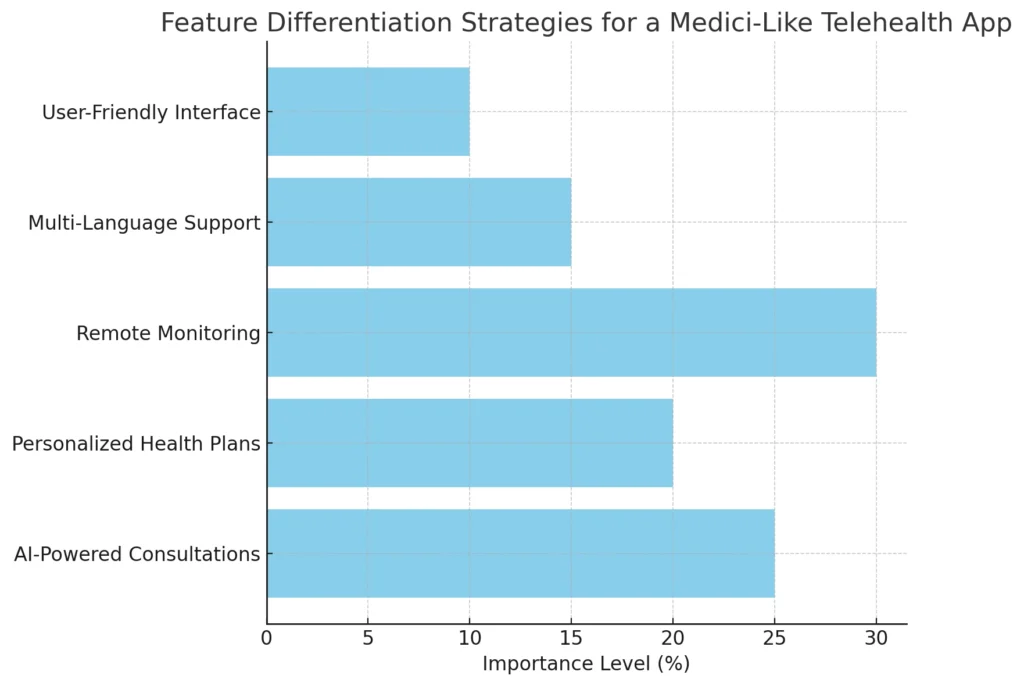
While building an app like Medici provides a strong foundation, standing out in the competitive telehealth market requires adding unique features that address unmet needs. One way to differentiate your app is by integrating AI-powered consultations. These tools can help triage patients or provide initial health assessments before a live consultation, enhancing both efficiency and user experience. Another potential feature is the use of personalized health plans, allowing doctors to create and update treatment protocols based on individual patient needs.
Moreover, adding remote health monitoring via wearable devices can provide continuous data to healthcare providers, offering real-time insights into a patient’s condition. For example, integrating data from smartwatches that monitor heart rate, sleep, and physical activity can give healthcare professionals a more holistic view of a patient’s health.
Localization is another strategy to make your app stand out. Offering multi-language support and adapting to regional healthcare regulations can make your app more appealing in diverse markets. Additionally, focusing on user-friendly interfaces with easy navigation and accessibility options for older or less tech-savvy users can further distinguish your app.
These enhancements not only set your app apart but also create more value for users, ensuring higher retention rates and long-term success.
Market Size, Growth, Revenue, and Business Model
The global telehealth market has experienced explosive growth in recent years, driven by increasing demand for remote healthcare solutions, particularly in the wake of the COVID-19 pandemic. As of 2023, the telemedicine industry is valued at over $100 billion, with projections estimating it will exceed $559 billion by 2027. This growth is largely fueled by advancements in technology, an aging population, and a shift in healthcare delivery toward more accessible and cost-effective models.
Building a Medici-like app gives you access to a market that spans across different sectors, from primary care consultations to mental health support and chronic disease management. The business model for telehealth apps typically revolves around subscription services, pay-per-consultation fees, and integration with health insurance for reimbursements. By offering flexible payment options, your app can cater to a wide audience, including individuals, hospitals, and corporate healthcare providers.
Moreover, telehealth apps open new revenue streams through partnerships with healthcare facilities, insurance companies, and even pharmaceutical firms. The ability to expand into diverse regions and offer services that can be customized to local healthcare regulations ensures long-term scalability and profitability.
With the right approach, you can not only build a successful telehealth platform but also tap into a rapidly growing market with immense revenue potential.
| Region/Category | Market Size (2023) | Projected Growth (2027) |
|---|---|---|
| North America | $45 billion | $140 billion |
| Europe | $25 billion | $90 billion |
| Asia-Pacific | $20 billion | $120 billion |
| Latin America | $5 billion | $30 billion |
| Telehealth for Primary Care | $30 billion | $180 billion |
| Mental Health Telemedicine | $10 billion | $60 billion |
| Chronic Disease Management | $15 billion | $100 billion |
Features of a Medici-like Telehealth App
To build a successful app like Medici, it’s crucial to focus on the core features that make telehealth apps both functional and user-friendly. These features not only enhance the user experience but also ensure that healthcare services are delivered effectively and securely.
- Secure Messaging and Video Consultations
One of the most important features is providing a secure channel for communication. This includes encrypted messaging and HD video consultations, allowing patients to discuss their health concerns with doctors in real-time. Ensuring compliance with data privacy laws, such as HIPAA, is essential to maintaining trust. - Appointment Scheduling
A seamless appointment scheduling system allows patients to easily book, reschedule, or cancel appointments. This system should integrate with the provider’s calendar, ensuring no time overlaps and providing reminders for upcoming sessions. - E-prescriptions
Allowing doctors to issue e-prescriptions directly through the app saves both time and effort for patients, eliminating the need for in-person visits just to receive medications. E-prescription functionality also enables integration with local pharmacies, simplifying the process for patients to get their medications. - Patient Health Records
Offering a comprehensive patient profile that includes previous consultations, treatment plans, and medication history is crucial for continuity of care. This feature helps doctors provide personalized care while allowing patients to track their own health progress. - Multi-language Support
Expanding your app’s reach with multi-language support allows users from different regions to use the app comfortably. This feature is especially important for serving diverse populations and broadening the app’s user base.
Minimum Viable Product (MVP)
When launching a Medici-like app, it’s essential to start with a Minimum Viable Product (MVP) that includes the most critical features, such as secure video consultations, appointment scheduling, and e-prescriptions. These basic functionalities allow you to test the market, gather feedback, and refine the app before adding more advanced features like AI-driven consultations or remote health monitoring.
Read More “How to Build an App Like PlushCare: A Step-by-Step Guide“
Technical Requirements
Building a telehealth app like Medici requires a solid technical foundation that ensures both functionality and security. The backbone of your app will be its technology stack, which includes the programming languages, frameworks, APIs, and cloud services used to create a seamless and scalable platform. Here’s a breakdown of the key technical components needed for a Medici-like app:
- Frontend and Backend Development
For the frontend, you’ll need a responsive and intuitive user interface. Common frameworks like React Native or Flutter allow for cross-platform development, ensuring that your app works smoothly on both iOS and Android devices. On the backend, technologies such as Node.js or Django provide the necessary infrastructure to manage user data, handle secure messaging, and support video consultations. A reliable backend is essential for scaling as your user base grows. - APIs for Secure Communication
Integrating third-party APIs is critical for enabling secure video calls and messaging. Services like Twilio or Agora are commonly used to support real-time communication in telehealth apps. These APIs ensure that interactions between patients and doctors are smooth and secure. - Database and Cloud Storage
Telehealth apps handle sensitive data, including patient records, prescriptions, and health histories. For secure data storage, cloud-based solutions like AWS or Google Cloud are widely used. Databases such as PostgreSQL or MongoDB help manage structured and unstructured data while ensuring quick access and scalability. - Security and Compliance
Protecting patient information is a top priority, especially in healthcare apps. Implementing end-to-end encryption, multi-factor authentication, and data anonymization are necessary to comply with healthcare regulations like HIPAA (in the U.S.) or GDPR (in Europe). Your app must adhere to these guidelines to operate legally and maintain user trust. - Performance and Load Management
As the user base increases, performance and load management become critical. Implementing a Content Delivery Network (CDN) and load balancing tools can help distribute traffic and ensure that the app remains responsive, even during peak usage times. These elements are key to scaling your app successfully.
By leveraging the right technology stack and ensuring your app is secure and compliant, you can create a robust telehealth platform that meets industry standards while delivering a seamless experience for users.
Design and User Interface (UI/UX)
In the telehealth space, the design and user experience (UI/UX) of your app play a critical role in its success. A well-designed interface can dramatically improve user engagement, while a poor design can lead to confusion and frustration, causing users to abandon the app. When building an app like Medici, focusing on a clean, intuitive design is essential for both patients and healthcare providers.
- Simple and Intuitive Navigation
Users, especially patients who may not be tech-savvy, need an interface that is easy to navigate. The app’s main features, such as scheduling appointments, video calls, and messaging, should be easily accessible from the home screen. Simplified menus, clear icons, and minimal text can guide users through the app effortlessly, ensuring a seamless experience. - Consistency Across Platforms
Whether a user accesses the app on a mobile phone, tablet, or desktop, the experience should be consistent. Responsive design ensures that the app functions smoothly across different devices, adapting to screen sizes without compromising usability. Tools like React Native allow for the development of a unified interface that works seamlessly across both iOS and Android devices. - Accessibility Features
Accessibility is an important consideration for telehealth apps, as they cater to a wide range of users, including elderly or disabled patients. Incorporating features such as larger text sizes, voice commands, and color contrast adjustments can make the app more accessible to everyone, ensuring inclusivity and enhancing user satisfaction. - Visual Appeal and Branding
The design of the app should reflect professionalism and trust, which are critical in healthcare. Using a soothing color palette, appropriate fonts, and consistent branding across all touchpoints can help establish credibility. The app’s design should convey a sense of security, particularly when handling sensitive patient data. - User Feedback and Iterative Design
Gathering user feedback after the app launch is crucial for improving UI/UX over time. Features such as in-app surveys or feedback buttons can help collect insights on usability issues, which can be addressed in future updates. This iterative approach ensures that the app evolves based on actual user needs, improving engagement and retention.
By prioritizing an intuitive design and user-friendly interface, your telehealth app can offer a smooth and satisfying experience, making it easier for users to access care and engage with healthcare providers.
From virtual visits to
AI-driven health insights!
Our Medici-style telehealth solution helps healthcare
providers improve patient access and engagement.
Development Process
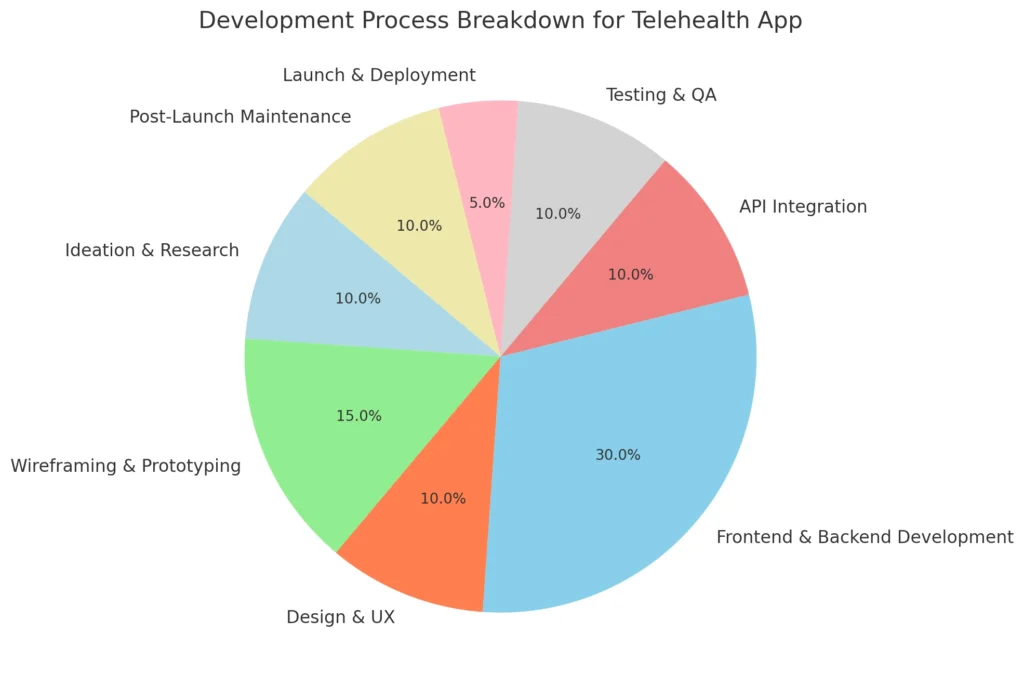
Building a telehealth app like Medici requires careful planning and execution, starting from the initial idea to the app’s launch. Following a structured development process ensures that the app meets user needs, adheres to healthcare regulations, and functions smoothly. Here’s a step-by-step breakdown of the development process:
- Ideation and Market Research
Before development begins, you must define your app’s purpose and conduct thorough market research. This involves identifying your target audience, understanding their pain points, and analyzing your competitors. Knowing what features are essential and what sets your app apart will guide the entire development process. - Wireframing and Prototyping
Once you have a clear vision, the next step is to create a wireframe—a simple visual guide that outlines the app’s structure and functionality. This helps you visualize the user journey and make necessary adjustments before moving on to development. After wireframing, a prototype is created, giving you and stakeholders a clickable version of the app to test its usability. - Design and User Experience (UX)
In this stage, the app’s user interface is designed, focusing on a seamless experience for both patients and healthcare providers. Ensuring that the design is responsive, intuitive, and accessible is crucial. The UX design process involves multiple iterations based on user feedback from the prototype. - Frontend and Backend Development
With the design in place, developers start coding the frontend (what users interact with) and backend (what powers the app). The frontend development is usually done using frameworks like React Native or Flutter, ensuring the app works on both iOS and Android. Meanwhile, the backend is built to handle user data, secure communication, and integrations with APIs for features like video calls or payment gateways. - Integration of APIs and Features
To deliver essential features like secure video consultations, messaging, and appointment scheduling, developers integrate third-party APIs. These tools allow the app to function efficiently without having to build every feature from scratch. Popular APIs for telehealth apps include Twilio for communication and Stripe for payment processing. - Testing and Quality Assurance (QA)
After development, the app undergoes rigorous testing to ensure it functions properly. This includes usability testing, performance testing, and security testing to ensure data protection. Any bugs or issues identified are resolved before the app is ready for launch. - Launch and Deployment
Once the app passes all tests, it’s time for the official launch. The app is deployed to app stores (Google Play and Apple App Store), ensuring it meets platform-specific guidelines. A well-executed launch strategy, including marketing efforts, can ensure that your app gains traction right from the start. - Post-Launch Maintenance and Updates
After launching, the development doesn’t stop. Ongoing maintenance is crucial to fix bugs, release new features, and ensure the app remains compliant with evolving regulations. Regular updates based on user feedback help to improve the app’s functionality and retain users over time.
By following this step-by-step development process, you ensure that the app is well-structured, secure, and ready for users. The right approach can minimize errors, save time, and result in a successful app that meets both business goals and user expectations.
Cost Estimation and Timeframe
| Development Stage | Global Cost Range | Miracuves Solutions Cost |
|---|---|---|
| Design & Prototyping | $1,500 – $3,000 | Included |
| Frontend & Backend Development | $20,000+ | Included |
| API Integration & Features | $3,000 – $10,000 | Included |
| Testing & QA | $1,000 – $5,000 | Included |
| Post-launch Maintenance | $500 – $2,000 (annually) | Included |
| Total Development Time | 1 – 3 Months | 10 Days |
Building a telehealth app like Medici involves several cost factors, from design and development to testing and post-launch maintenance. Globally, developing a custom app from scratch can range between $5,000 to $100,000, depending on the complexity of features and the region of development. However, with ready-made solutions, like those provided by Miracuves Solutions, the cost drops significantly to around $600, which is just a fraction of the global price.
The primary costs include:
- Design & Prototyping
Custom design and prototyping can cost between $1,500 to $3,000 globally, but this is often included at no extra charge with ready-made solutions. Having a solid design that resonates with users is essential for ensuring user engagement from day one. - Frontend & Backend Development
Developing the user interface (frontend) and backend infrastructure to handle user data, appointments, and consultations is the most expensive part of the process. Global costs can reach $20,000 or more, but with pre-built frameworks, this cost is drastically reduced, with Miracuves Solutions offering it at a much lower price. - API Integration & Features
Integrating APIs for secure communication, video calls, and payment gateways typically adds $3,000 to $10,000 to the global development budget. In contrast, Miracuves includes these core features within its package. - Testing and Quality Assurance (QA)
Ensuring the app functions smoothly across devices requires extensive testing, which can cost anywhere between $1,000 to $5,000 globally. With ready-made solutions, QA is often built into the service, saving additional costs. - Post-launch Maintenance
Ongoing maintenance to fix bugs, release updates, and ensure compliance with regulations can cost $500 to $2,000 annually. Miracuves Solutions provides post-launch support, ensuring your app stays functional and compliant.
Timeframe for Development
The global average timeframe for custom app development is around 1 to 3 months, depending on the app’s complexity. However, with Miracuves Solutions, you can have a fully functioning telehealth app ready to launch in just 10 days. This significant reduction in development time allows you to bring your product to market quickly, giving you a competitive edge in a rapidly growing industry.
Monetization Strategies
Creating a telehealth app like Medici not only improves healthcare access but also opens up a variety of revenue streams. A well-planned monetization strategy is key to ensuring the app’s sustainability and profitability. Here are some common and effective monetization methods for telehealth apps:
- Subscription-Based Model
One of the most popular monetization strategies is offering subscription plans for both patients and healthcare providers. Users pay a monthly or annual fee to access premium features such as unlimited consultations, priority appointment booking, or access to specialist care. This recurring revenue model ensures consistent cash flow and long-term user engagement. - Pay-Per-Consultation
Another effective revenue stream is the pay-per-consultation model, where patients are charged per doctor visit or session. This is especially useful for users who may not need frequent consultations and prefer to pay only when they use the service. Offering different pricing tiers based on the type of consultation (e.g., general practice vs. specialist) can further enhance revenue. - In-App Purchases
Telehealth apps can offer additional services through in-app purchases, such as access to personalized health plans, wellness programs, or downloadable educational materials. These add-ons create value for users while providing an additional source of income. - Insurance Partnerships
Partnering with health insurance companies is another way to monetize the app. By integrating with insurance providers, you can offer covered services directly through the app, enabling patients to book consultations and receive treatment without worrying about upfront costs. This model provides a win-win scenario where patients access care, and insurance companies ensure proper billing. - Advertising and Sponsored Content
While this is a less common method for telehealth apps due to the sensitive nature of healthcare, some apps generate revenue through advertising and sponsored content. For instance, pharmaceutical companies or health-related brands can promote products within the app in a non-intrusive way, such as in the educational sections or as recommended services. - Commission-Based Fees
Telehealth apps can also charge a commission-based fee to healthcare providers for using the platform. Providers pay a percentage of each consultation fee earned through the app, which incentivizes the app to deliver high-quality service while maintaining a fair revenue share for doctors.
By combining multiple monetization strategies, you can maximize the app’s profitability while providing value to both patients and healthcare providers.
Launching and Marketing the App
After developing your telehealth app, the next critical step is launching it successfully and ensuring it reaches the right audience. A well-planned launch strategy can make the difference between a slow start and rapid user adoption. Here are the key steps to consider for a successful app launch:
- App Store Optimization (ASO)
Just like SEO for websites, App Store Optimization (ASO) is crucial for increasing your app’s visibility in the Apple App Store and Google Play. Optimizing your app’s title, keywords, description, and screenshots will help your app rank higher in search results and attract more downloads. Choose keywords related to telehealth, remote healthcare, or medical consultations to reach your target audience effectively.
Just like SEO for websites, App Store Optimization (ASO) is crucial for increasing your app’s visibility in the Apple App Store and Google Play.
- Pre-launch Marketing Campaign
Building buzz before the launch can significantly boost your app’s success. Start by creating a landing page for your app that showcases its key features, benefits, and a sign-up form for updates. Running targeted ads on social media platforms like Facebook, Instagram, and LinkedIn can also help attract attention from potential users. Additionally, offering early access to healthcare providers or influencers in the medical field can generate valuable testimonials and word-of-mouth marketing. - Leverage Email Marketing
Email marketing remains one of the most effective tools for nurturing leads and converting them into app users. Build a mailing list through your pre-launch marketing efforts and send personalized emails that highlight the app’s features and how it can improve the healthcare experience. You can also offer exclusive launch-day promotions to drive sign-ups. - Partnerships with Healthcare Providers
Partnering with clinics, hospitals, and healthcare networks can give your app an instant user base. By offering incentives such as discounted subscriptions for healthcare providers or special features for their patients, you can encourage healthcare professionals to promote your app to their patients. - Social Media and Content Marketing
Use social media platforms to educate your audience about the benefits of telehealth and how your app can improve access to care. Share engaging content like how-to videos, success stories, or blog posts about healthcare trends to establish your app as a trusted resource in the telehealth space. You can also collaborate with healthcare influencers who can share your app with their followers. - Monitor and Respond to User Feedback
Once the app is live, monitoring user feedback is essential for making continuous improvements. Promptly address any issues or concerns raised by users through app store reviews or customer service. Positive reviews and high ratings can significantly influence new users to download your app, so ensure that the user experience is always a top priority.
By following these strategies, you can ensure a smooth launch for your telehealth app, increase visibility, and drive user adoption.
Legal and Regulatory Considerations
Launching a telehealth app like Medici involves navigating complex legal and regulatory landscapes to ensure compliance with healthcare standards and data protection laws. Since telemedicine deals with sensitive patient information, adhering to these regulations is crucial to avoid legal penalties and to build trust with your users. Below are the key legal and regulatory considerations you need to address:
- HIPAA Compliance
In the United States, the Health Insurance Portability and Accountability Act (HIPAA) governs how healthcare providers handle patient data. For any telehealth app, compliance with HIPAA is mandatory. This means implementing strict security measures such as end-to-end encryption for all communications, ensuring that sensitive data like medical records and personal health information are securely stored and transmitted. Additionally, user authentication methods such as multi-factor authentication (MFA) help meet these requirements. - GDPR Compliance
If your app serves users in the European Union, you’ll need to comply with the General Data Protection Regulation (GDPR). GDPR emphasizes transparency in how user data is collected, stored, and used. It requires users to give explicit consent before their personal data is processed, and they must have the ability to access, correct, or delete their data. Failure to comply with GDPR can result in severe fines. - Data Storage and Encryption
Storing patient data securely is a top priority. You must use encrypted databases to store medical information and ensure that only authorized personnel can access this data. Implementing secure cloud storage solutions such as Amazon Web Services (AWS) or Google Cloud that offer compliance with healthcare data standards is a common practice in the industry. - Telemedicine Licensing and Reimbursement
In many regions, healthcare providers need specific licenses to offer telemedicine services. This varies from country to country, and even within states in the U.S., regulations around telemedicine licenses differ. You must verify that healthcare providers using your app are licensed to provide telehealth services in the regions they operate in. Additionally, ensuring that your app’s services are eligible for insurance reimbursement can make your platform more appealing to both users and providers. - Terms of Service and Privacy Policies
Your app must include clear terms of service and a privacy policy that explain how user data will be handled, stored, and shared. These documents should outline the rights of users, including their ability to access their data or revoke consent for its use. Make sure to provide these documents during the sign-up process to ensure transparency and legal coverage. - Informed Consent
Before patients engage in telehealth consultations, they must give informed consent, acknowledging that they understand the risks and benefits of receiving medical care remotely. This can be achieved through a simple digital consent form integrated into the app before any consultations take place.
By ensuring your telehealth app complies with these legal and regulatory requirements, you can protect your business from legal risks while creating a secure, trustworthy platform for users. Taking these steps will also increase your app’s credibility with both healthcare providers and patients.
In the United States, the Health Insurance Portability and Accountability Act (HIPAA) governs how healthcare providers handle patient data.
Future Growth of the App
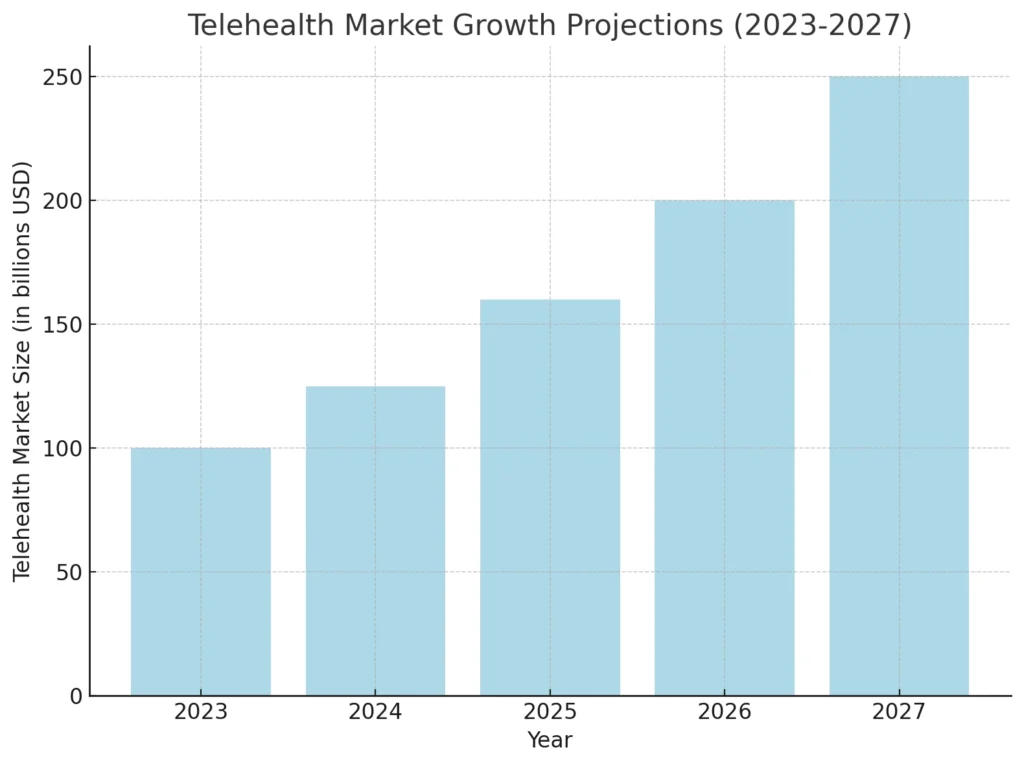
As the telehealth industry continues to evolve, building an app like Medici positions your business for significant long-term growth. The future of telehealth is driven by advancements in technology, expanding patient demographics, and an increasing need for more accessible and cost-effective healthcare solutions. Here’s how you can plan for the future growth of your telehealth app:
- Scalability
One of the most important aspects of future-proofing your app is ensuring its scalability. As your user base grows, your app must handle larger volumes of patient data, more consultations, and additional healthcare providers. Leveraging cloud-based infrastructure like AWS or Google Cloud allows your app to scale seamlessly without compromising performance. By planning for scalability from the start, your app can grow alongside the increasing demand for telehealth services. - Expansion of Features
Future growth is not only about expanding the user base but also about enhancing the app’s features. Over time, you can integrate advanced technologies like artificial intelligence (AI) for automated patient triage, machine learning for personalized healthcare recommendations, and IoT (Internet of Things) integration to monitor patients’ health using wearable devices. These features not only improve the user experience but also keep your app relevant in a rapidly changing industry. - Geographic Expansion
As telehealth regulations evolve, opportunities for geographic expansion become more feasible. By complying with international healthcare regulations such as GDPR in Europe or local telemedicine laws in various countries, your app can expand its services to new markets. Multi-language support and localization features can further enhance your app’s appeal to a global audience. - Partnerships with Healthcare Networks
Future growth also depends on strategic partnerships. Collaborating with hospitals, clinics, and insurance companies can help you expand your reach and credibility. By integrating your app into the workflows of established healthcare networks, you can attract more healthcare providers and patients, creating a robust ecosystem. - Data Analytics and Insights
As your app grows, leveraging data analytics will become essential for optimizing services. Analyzing patient data trends can help you identify areas for improvement, such as popular consultation types or common user issues. This data can guide the development of new features and help refine your app to better meet user needs. - Telehealth Market Growth Projections
The telehealth market is expected to continue its rapid expansion, with analysts projecting a compound annual growth rate (CAGR) of over 25% through 2027. By positioning your app to take advantage of this growth, you can capture a significant share of the market and become a leader in telemedicine services.
By focusing on scalability, expanding features, and exploring new markets, your telehealth app can thrive in the long term. With a clear growth strategy, you can stay ahead of the competition and continue providing valuable healthcare services to users.
Why Do You Trust Miracuves Solutions for Your Next Project?
When it comes to building a telehealth app like Medici, trust and reliability are crucial. Choosing Miracuves Solutions as your development partner offers several compelling reasons to ensure the success of your project:
- Cost-Effective Development
One of the biggest challenges in developing a telehealth app is managing costs, especially when building from scratch. Miracuves Solutions offers ready-made solutions at just 10% of the global cost, allowing you to create a high-quality app for a fraction of the price. This cost advantage doesn’t compromise on quality, meaning you get a fully functional, secure, and compliant app without overspending. - Faster Time to Market
In a competitive market like telehealth, speed is everything. Miracuves Solutions reduces the development timeline from one month globally to just 10 days, ensuring that your app reaches users quickly. This rapid turnaround time allows you to capture market opportunities faster, giving you an edge over competitors who may still be in the early stages of development. - Comprehensive Ready-Made Solutions
Unlike other platforms that only offer templates or design mockups, Miracuves Solutions provides a full suite of ready-made solutions, including essential telehealth features like secure video consultations, appointment scheduling, and patient record management. You don’t need to worry about integrating these features from scratch, as they come pre-built and fully customizable to suit your business needs. - Customization and Scalability
While Miracuves Solutions offers ready-made features, the platform also allows for extensive customization. You can tailor the app to reflect your brand, incorporate new features, or modify existing ones to meet specific market demands. As your user base grows, the app can easily scale to handle additional traffic and more complex requirements. - Compliance with Healthcare Regulations
Ensuring your app complies with healthcare regulations like HIPAA or GDPR is critical for protecting patient data and avoiding legal complications. Miracuves Solutions takes care of this by integrating data privacy and security protocols into the app’s core architecture. This built-in compliance saves you time and money, allowing you to focus on other aspects of your business. - Post-Launch Support
The journey doesn’t end once your app goes live. Miracuves Solutions offers comprehensive post-launch support, ensuring that your app remains functional, updated, and secure. Whether you need to address technical issues or release new features, their ongoing support ensures your app continues to deliver a high-quality experience to users.
By choosing Miracuves Solutions, you’re not just getting a development partner; you’re securing a team that prioritizes your success with cost-effective, timely, and reliable solutions. With their expertise, you can confidently enter the telehealth market and create an app that stands out.
Conclusion
Building a telehealth app like Medici offers immense potential in today’s rapidly evolving healthcare landscape. With the increasing demand for remote healthcare solutions, developing an app that connects patients and healthcare providers seamlessly can position your business for success. By choosing Miracuves Solutions, you gain access to a cost-effective, ready-made solution that can be customized to your needs, all while significantly reducing development time and cost.
Miracuves Solutions not only delivers high-quality apps at 10% of the global cost but also ensures that your app is fully functional within 10 days, giving you the competitive edge needed to thrive in the telehealth market. Whether you’re looking to provide secure video consultations, streamline appointment scheduling, or manage patient data, Miracuves Solutions provides everything you need to create a robust and scalable telehealth platform.
By leveraging their expertise, you can confidently launch a telehealth app that meets industry standards, complies with healthcare regulations, and delivers an exceptional user experience to both patients and healthcare providers.
Bring healthcare to
patients’ fingertips!
Whether it’s video consultations, remote patient monitoring, or in-app messaging with doctors, we help you build a user-friendly and feature-rich telemedicine app.
FAQs
How much does it cost to build an app like Medici?
Building a custom telehealth app globally can cost anywhere from $5,000 to $100,000, but with Miracuves Solutions, you can get a ready-made app for around $600, offering significant savings.
How quickly can I develop a telehealth app with Miracuves Solutions?
With Miracuves Solutions, you can have a fully functional telehealth app ready in just 10 days, compared to the global average of one month or more.
What features should I include in my MVP for a telemedicine app?
For a minimum viable product (MVP), the essential features include secure video consultations, appointment scheduling, and e-prescriptions. These features ensure your app offers value from the start while allowing room for growth.
How do I ensure my app is HIPAA-compliant?
Miracuves Solutions ensures HIPAA compliance by implementing end-to-end encryption, secure data storage, and multi-factor authentication, so patient information remains protected at all times.
Can I customize my telemedicine app with ready-made solutions?
Yes, Miracuves Solutions allows for extensive customization, enabling you to tailor the app’s design, features, and functionalities to match your specific business needs.
Explore innovative healthcare services by Miracuves – crafted for reliability, accessibility, and care on demand:
Netmeds Like Service – An online pharmacy app offering doorstep medicine delivery, prescription uploads, and health essentials.
Practo Like Service – A doctor booking app with appointment scheduling, telemedicine, and health records management.
Customizable PharmEasy Like Service – A flexible pharmacy delivery app supporting diagnostics, medicine ordering, and healthcare products.
Lybrate Like Service – A health consultation app connecting users to certified doctors for advice, prescriptions, and follow-ups.



